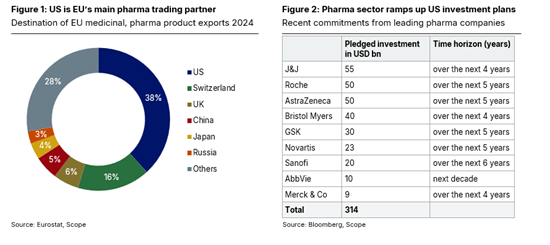Announcements
Drinks
US pharma tariffs redirect investment, spreading credit risk unevenly across sector’s value chain
By Azza Chammem, Corporates Ratings
The White House has set an effective date of October 1 but is yet to clarify which products or pharmaceutical inputs (finished goods, active pharmaceutical ingredients (APIs), intermediates) will fall under the 100% tariff and how tariff exemptions for companies building US plants will be interpreted and enforced.
For example, it is still unclear what qualifies as a ‘factory under construction,’ raising questions over whether the current or planned EUR 170bn in expansion projects by European pharmaceutical companies in the US will be enough for them to escape the 100% levy.
Whatever the final regime, the financial impact potentially runs into billions of euros for European corporates. The EU is the largest exporter of pharmaceutical products to the US, with exports reaching approximately EUR 120bn in 2024 (Figure 1).
Larger, investment-grade pharma companies look inevitably better placed to absorb the extra direct and indirect costs than smaller players which face heightened credit risk and potential ratings volatility as a result. Regardless of the size of the company, however, the sector is at a potential inflection point, where US policy is set to profoundly reshape profitability, investment priorities, and long-term credit strength, particularly if politically driven investment and supply-chain costs crowd out spending on research and development, putting long-term cashflows in jeopardy.
 European companies have pledged around USD 170bn in US investment
European companies have pledged around USD 170bn in US investment
The 100% tariff on branded pharmaceutical imports from the EU, effective October 1, ends the temporary relief provided by previous delays during US-EU trade talks.
The European industry’s response is well underway, from short-term stockpiling to shield US sales, while investing to increase US-based production in the longer term. However, while aligning manufacturing and regulatory activities with Federal Drug Administration requirements and local patient needs is indispensable when the US represents roughly 40% of global pharma sales, the price tag is not small. European companies such as AstraZeneca, GSK, Novartis, Roche and Sanofi (AA/Stable) have pledged around USD 170bn in investment in the US in the coming years, responsible for more than half of the USD 314bn that the world’s largest pharma companies have promised (Figure 2).
Novartis, for instance, has announced USD 23bn in US investment to address gaps in its domestic production chain, while Novo Nordisk plans to manufacture its semaglutide oral obesity drug entirely in the U.S. GSK has committed USD 30bn over five years for US R&D and manufacturing.
These long-term bets also position companies to qualify for tariff exemptions so medium-term expense may be offset by longer-term avoidance of even higher costs, thereby supporting value creation, resilience, and ultimately, credit ratings.
Tariffs on finished products would squeeze European industry the hardest
While European sector’s investment commitments signal alignment with US policy objectives, the full credit impact remains uncertain, partly hinging on whether the US imposes tariffs on finished drugs or inputs like APIs and packaging.
Tariffs on branded medicines would be the most damaging for profitability. First, they represent much of the industry’s cost structure. Secondly, the companies cannot pass higher costs on to customers in their home markets due to regulated pricing in Europe.
In contrast, if the White House targets APIs, the impact would be less severe, as they represent only around 10% of the cost of a finished small-molecule drug. API pricing can often be renegotiated along the value chain.
The main risk rather lies in more volatile cashflow and potentially higher investments if the new tariffs lead to production bottlenecks, a problem amplified by the industry’s reliance on a fragmented global supply chain, with API production concentrated in a handful of regions, particularly China and India (Figure 3). Only about 15% of branded-drug API volume is produced in the US, while roughly 43% is sourced from the EU. Manufacturers cannot easily mitigate extra supply-chain costs, given regulatory barriers to switching suppliers.
 Tariffs raise doubts over efficient capital allocation
Tariffs raise doubts over efficient capital allocation
For the European industry, the full potential financial impact is twofold. First, tariff-related cost pressures would coincide with a weaker dollar, further compressing margins for European companies that report in euros or Swiss francs.
Secondly, large-scale US capex commitments raise questions about capital allocation. While investments in new plant support long-term supply resilience, they increase upfront cash outflows and could constrain financial flexibility. Elevated capex can crowd out R&D spending, which typically absorbs 15%–20% of revenue for the largest players and is a main driver of long-term credit strength.
For now, company guidance points to resilience, partly due to existing US inventories and investment in US production. Sanofi, for example, sees a limited short-term impact in 2025, partly due to its local drug stocks, and is sticking to earnings guidance in its base-case scenario.
Indeed, the multibillion-dollar US investment pledges are unlikely to necessitate material changes to funding structures or leverage metrics for the largest European players in the near term, given their ample cashflows and access to debt markets.
At lower levels of the rating scale, the outlook is cloudier. Smaller producers and API specialists often operate with tighter balance sheets, limited cash buffers, and less flexible cost structures. For these issuers, elevated capex or tariff-induced cost pressures could exacerbate existing vulnerabilities, reduce their ability to absorb unexpected shocks, and heighten the risk of credit deterioration.







